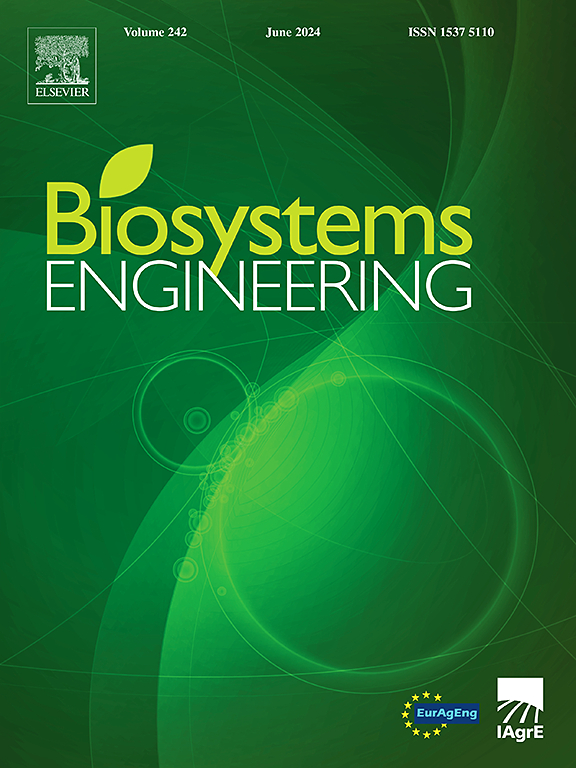Cross-modal data fusion and deep learning techniques enabled non-destructive fish vitality recognition during cryogenic waterless live transport
IF 5.3
1区 农林科学
Q1 AGRICULTURAL ENGINEERING
引用次数: 0
Abstract
Cryogenic waterless live transport (CWLT) is widely regarded as a green, efficient and low-carbon transportation strategy, which can ensure a certain degree of fish survival rates, enhance water resource utilisation and reduce transportation costs. This study focuses on the pearl gentian grouper, integrating multi-modal sensors, deep learning and cross-modal data fusion techniques for non-destructive vitality recognition during the live transport process. Changes in fish surface and physiological characteristics were captured based on multi-modal sensors. A cross-modal vitality recognition network (CmVRNet) was developed based on cross-modal data fusion and multi-input deep learning techniques. The enhanced whale optimisation algorithm based on multi-strategy fusion (EWOAm) was developed to optimise hyperparameters of the model (EWOAm-CmVRNet). The results showed that: (1) Cluster analysis classified physiological status of the grouper into four categories: high vitality (HV), medium vitality (MV), weak vitality (WV) and near death (ND), with significant differences between physiological data of fish with different vitality levels but the same size (P < 0.05); (2) EWOAm demonstrated significant performance, successfully addressing shortcomings of the standard WOA and outperforming other comparison algorithms, achieving a balance between global exploration and local search; (3) EWOAm-CmVRNet showed excellent vitality recognition performance. For large groupers, the model achieved the average precision of 93.74 %, average recall of 93.89 %, average F1 score of 93.81 %, average specificity of 97.88 % and average accuracy of 93.69 %; (4) The EWOAm-CmVRNet model, which is constructed based on cross-modal data, outperformed other single-modal vitality recognition models. This study aims to provide technical support to enhance market competitiveness of live aquatic products.
跨模式数据融合和深度学习技术在低温无水活体运输过程中实现了无损鱼类活力识别
低温无水活体运输(CWLT)被广泛认为是一种绿色、高效、低碳的运输策略,可以保证一定程度的鱼类成活率,提高水资源利用率,降低运输成本。本研究以龙胆石斑鱼为研究对象,结合多模态传感器、深度学习和跨模态数据融合技术,在活体运输过程中进行无损活力识别。基于多模态传感器捕捉鱼类表面和生理特征的变化。基于跨模态数据融合和多输入深度学习技术,构建了一种跨模态活力识别网络。提出了基于多策略融合的增强型鲸鱼优化算法(EWOAm),对模型的超参数进行优化。结果表明:(1)聚类分析将石斑鱼的生理状态分为高活力(HV)、中等活力(MV)、弱活力(WV)和接近死亡(ND) 4类,不同活力水平但体型相同的鱼类生理数据差异显著(P <;0.05);(2) EWOAm表现出显著的性能,成功地解决了标准WOA的不足,并优于其他比较算法,实现了全局搜索和局部搜索的平衡;(3) EWOAm-CmVRNet具有优异的生命力识别性能。对于大型石斑鱼,模型的平均准确率为93.74%,平均召回率为93.89%,平均F1评分为93.81%,平均特异性为97.88%,平均准确率为93.69%;(4)基于跨模态数据构建的EWOAm-CmVRNet模型优于其他单模态活力识别模型。本研究旨在为提高活水产品的市场竞争力提供技术支持。
本文章由计算机程序翻译,如有差异,请以英文原文为准。
求助全文
约1分钟内获得全文
求助全文
来源期刊

Biosystems Engineering
农林科学-农业工程
CiteScore
10.60
自引率
7.80%
发文量
239
审稿时长
53 days
期刊介绍:
Biosystems Engineering publishes research in engineering and the physical sciences that represent advances in understanding or modelling of the performance of biological systems for sustainable developments in land use and the environment, agriculture and amenity, bioproduction processes and the food chain. The subject matter of the journal reflects the wide range and interdisciplinary nature of research in engineering for biological systems.
 求助内容:
求助内容: 应助结果提醒方式:
应助结果提醒方式:


